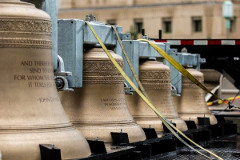
January 23, 2015 — The chiming of bells has long been heard on Loyola University Chicago’s campus, but until recently, no actual bells existed in the Madonna della Strada Chapel tower. While bells were always planned for the chapel, which was built during the Great Depression, a lack of funds prevented them from being commissioned for 75 years.
That changed on Nov. 3, when four new bells donated to the school were hoisted to the top of the tower. Their first official ringing was Nov. 16, and they are now set to chime on the hour. Every 15 minutes, the new bells will also play “Madonna Quarters,” a melody composed by Stephen Betancourt, Loyola Chicago’s assistant director of Campus Ministry and director of liturgical music.
Named Joseph, James,
Cecilia and Ignatius, the four custom-made bronze bells arrived at Loyola in
October and were put on temporary display around the campus. The largest bell
is Ignatius, weighing 1,990 pounds and honoring St. Ignatius of Loyola. It has the
lowest pitch of the four bells and rings at the beginning of each hour. Cecilia
is the next largest, weighing 836 pounds, a gift from couples who were married
in the chapel. James is 583 pounds, named in honor of Jesuit
Father James Mertz, the
Jesuit who turned his dream of a Loyola chapel into reality by inspiring the
construction for the Madonna della Strada. Fr. Mertz’s bell now rings at the
beginning of Mass. Lastly, Joseph is 407 pounds, in memory of St. Joseph
Pignatelli, the Jesuit who helped restore the Society of Jesus in 1814 after it
was suppressed by papal brief for 41 years.
Previously, church bells were mimicked by a sound system in the rafters of the chapel, playing a prerecorded sequence of tones and rings. According to Betancourt, the speakers had constant malfunctions because of weather.
The project was largely funded through the church's donors, and the bells were designed by a manufacturer based in Cincinnati. However, because Ignatius weighs almost 2,000 pounds, the bells had to be cast at a foundry in the Netherlands — one of a few locations in the world still capable of making bells of that size.
When the bells were delivered to Cincinnati for engraving, Betancourt and other Loyola representatives went to the factory to ring them for the first time. “There’s so much sonic energy from the sound waves, you could feel it actually hit your body. It’s incredible but overwhelming, to feel something that strong come from a sound,” Betancourt said.
Listen to an interview about the bells in the Soundcloud module and hear the bells ringing in the video embedded below. [Sources: DNAinfo, Loyola Student Dispatch, Loyola Phoenix]